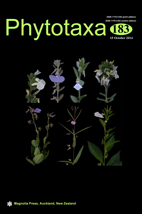Abstract
Poa anfamensis, P. jujuyensis, P.lilloi, P. parviceps and P. scaberula (Poaceae) are a group of morphologically similar species. These species inhabit cool grasslands and mesic puna. They are highly polymorphic and their circumscriptions are uncertain, especially the entities around P. scaberula. Univariate and multivariate analyses (PCA and DA) were conducted to evaluate the morphological variation among 150 herbarium specimens identified as P. anfamensis, P. jujuyensis, P. lilloi, P. parviceps and P. scaberula. Forty morphological characters were included and their patterns of variation were analyzed among specimens, together with their relationship with environmental variables, using correlation analysis. The relationships between morphological variation and geographical distance, and climatic variables among specimens, were compared with Mantel permutation tests. Taxa were delimited according to the observed clustering of specimens in the PCA plots and DA, and diagnostic characters were identified. The five taxa showed continuous morphological variation. Morphological variation is explained by geographical and climatic factors such as elevation, geographical distance, latitudinal and longitudinal gradients, temperature and precipitation in the different sites in the Andes. Altitudinal and geographical distance are apparently more decisive factors in phenotypic differentiation and could have played a large role in interspecific differentiation among Poa entities, as shown by the stronger and significant association between vegetative and reproductive phenotype and altitudinal distance, and between vegetative and reproductive phenotype and geographical distance. In addition, we observed uncoupling among vegetative and floral characters in Poa specimens that grow along environmental gradients; these characters are responding independently to different abiotic forces promoting genetic divergence and speciation. Based on the results, P. anfamensis and P. parviceps are synonymised with P. scaberula, and P. jujuyensis is synonymised with P. lilloi.

